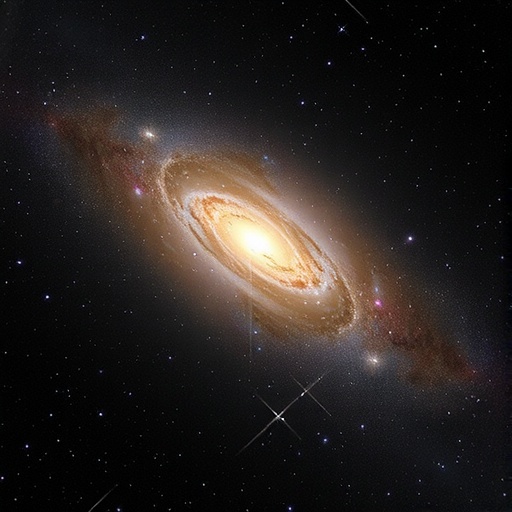In a groundbreaking study, astronomers at Brown University have unveiled a remarkable phenomenon within the galaxy cluster Abell 3667, located an astonishing 700 million light-years from Earth. The research harnesses a meticulously gathered dataset, deemed one of the most detailed ever obtained for a galaxy cluster, revealing the faint glow of individual stars that are indicated as being torn from their respective galaxies and absorbed into a larger one. This incredible find provides the first direct evidence of an ongoing merger between the two most prominent galaxies within this cluster.
The cosmic bridge of diffuse light, measuring approximately one million light-years in length, is a subtle yet formidable reminder of the violent and dynamic nature of our universe. It reflects the complex interactions occurring between galaxies as they merge into one another, showcasing a process that has long been theorized but scarcely observed. The study’s lead author, Anthony Englert, a Ph.D. candidate at Brown University, noted the unprecedented scale of this phenomenon, emphasizing that such a feature had not been documented before in a local galaxy cluster. The ability to capture such a faint structure was both unexpected and exciting for the research team and the broader astronomical community.
For the observations, the researchers utilized the Dark Energy Camera, which boasts an impressive 570-megapixel resolution, mounted on the Víctor M. Blanco Telescope located at Cerro Tololo Inter-American Observatory in Chile. A staggering 28 hours of imaging was consolidated from multiple years of observations, contributing to the culmination of this significant scientific endeavor. The integration of archival data played a vital role in facilitating the discovery. Englert expressed gratitude for the past decade of imaging efforts that had been conducted using the Dark Energy Camera, which enabled the team to assemble such a comprehensive view of Abell 3667.
The diffuse light captured, known as intracluster light (ICL), serves as a window into the history of the cluster itself as well as the gravitational interactions between its constituent galaxies. This light is produced by stars that have been ejected from their parent galaxies as they undergo gravitational interactions with nearby galaxies. By observing this light, astronomers hope to glean insights into the past and present dynamics of galaxy clusters, particularly regarding the mergers that shape the cosmic landscape.
In the context of Abell 3667, the team discovered an atypical merging scenario involving two galaxy clusters, each possessing its own brightest cluster galaxy, or BCG. Traditional understanding suggests that when a BCG engages in a merger with surrounding smaller galaxies, it does so gradually over time. However, the findings from Abell 3667 reveal a more aggressive merger, where the larger BCG appears to be stealing stars from the smaller counterpart. This rapid merger presents a unique galactic scenario, and the discovery of the ICL bridge stands as the first optical evidence supporting this dynamic.
Data collected from X-ray and radio frequency observations had hinted at the potential for a rapid merger, yet this observational study marks a pivotal moment in validating those hypotheses. The presence of ICL illuminates the intricate gravitational dance occurring within galaxy clusters as galaxies collide and coalesce over billions of years. Each interaction leaves behind faint traces of light that tell the story of the cosmos itself, offering clues to the origins and evolution of galaxy structures.
Looking forward, the astronomical community anticipates exciting advancements with the upcoming Vera C. Rubin Observatory, which is set to become fully operational in late 2024 or early 2025. With a telescope twice the size of the Blanco and equipped with the largest camera ever constructed, the Rubin Observatory aims to conduct an expansive survey of the southern sky over the course of a decade. This ambitious project, dubbed the Legacy Survey of Space and Time, promises to revolutionize our understanding of intracluster light across numerous local galaxy clusters, exponentially increasing the data available for future studies.
The potential implications of this research extend far beyond mere cosmic curiosity. The ICL represents a key element in unveiling the mysteries of dark matter, as its distribution is thought to be closely related to the distribution of this elusive substance. Dark matter, an unseen component of the cosmos believed to comprise most of the universe’s mass, has puzzled scientists for decades. As researchers utilize ICL as a proxy to infer the presence of dark matter, new avenues for exploring fundamental questions in cosmology will emerge.
The Victor M. Blanco Telescope and the Vera C. Rubin Observatory are pivotal assets under the stewardship of NOIRLab, the U.S. center dedicated to ground-based optical astronomy, operated by the National Science Foundation. Funding for the research was generously provided by various organizations, including the National Science Foundation and the U.S. Department of Energy, underscoring the collaborative nature of astronomical research that pushes the boundaries of our understanding of the universe.
As we peer deeper into the cosmos, studies such as this one not only expand our knowledge of galaxy dynamics but also illuminate the significance of intracluster light as a beacon revealing the complex interplay of dark matter and the visible universe. The merging processes and the faint stellar traces left behind serve as a reminder of the ever-evolving dance of galaxies, shaping the cosmos in profound and mysterious ways.
Subject of Research: Galaxy cluster mergers and intracluster light.
Article Title: The Intracluster Light of Abell 3667: Unveiling an Optical Bridge in LSST Precursor Data.
News Publication Date: 5-Aug-2025.
Web References: The Astrophysical Journal.
References: 10.3847/2041-8213/ade8f1.
Image Credits: CTIO/NOIRLab/NSF/AURA.
Keywords
Galaxy mergers, intracluster light, dark matter, Abell 3667, cosmic observations, astronomical research, Vera C. Rubin Observatory, merging clusters, astrophysics.




